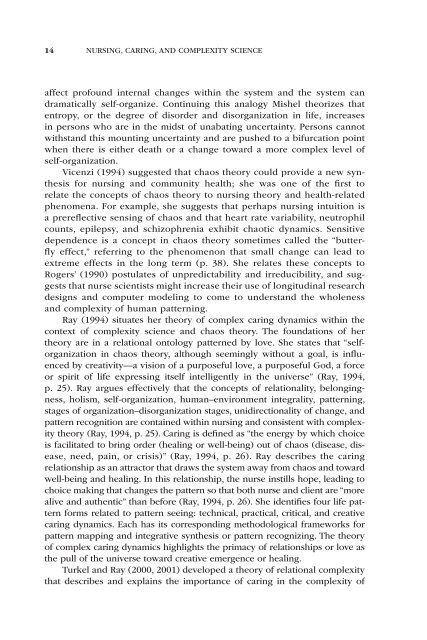Nursing, Caring, and Complexity Science: For Human ... - Axon
Nursing, Caring, and Complexity Science: For Human ... - Axon
Nursing, Caring, and Complexity Science: For Human ... - Axon
Create successful ePaper yourself
Turn your PDF publications into a flip-book with our unique Google optimized e-Paper software.
14 NURSING, CARING, AND COMPLEXITY SCIENCE<br />
affect profound internal changes within the system <strong>and</strong> the system can<br />
dramatically self-organize. Continuing this analogy Mishel theorizes that<br />
entropy, or the degree of disorder <strong>and</strong> disorganization in life, increases<br />
in persons who are in the midst of unabating uncertainty. Persons cannot<br />
withst<strong>and</strong> this mounting uncertainty <strong>and</strong> are pushed to a bifurcation point<br />
when there is either death or a change toward a more complex level of<br />
self-organization.<br />
Vicenzi (1994) suggested that chaos theory could provide a new synthesis<br />
for nursing <strong>and</strong> community health; she was one of the first to<br />
relate the concepts of chaos theory to nursing theory <strong>and</strong> health-related<br />
phenomena. <strong>For</strong> example, she suggests that perhaps nursing intuition is<br />
a prereflective sensing of chaos <strong>and</strong> that heart rate variability, neutrophil<br />
counts, epilepsy, <strong>and</strong> schizophrenia exhibit chaotic dynamics. Sensitive<br />
dependence is a concept in chaos theory sometimes called the “butterfly<br />
effect,” referring to the phenomenon that small change can lead to<br />
extreme effects in the long term (p. 38). She relates these concepts to<br />
Rogers’ (1990) postulates of unpredictability <strong>and</strong> irreducibility, <strong>and</strong> suggests<br />
that nurse scientists might increase their use of longitudinal research<br />
designs <strong>and</strong> computer modeling to come to underst<strong>and</strong> the wholeness<br />
<strong>and</strong> complexity of human patterning.<br />
Ray (1994) situates her theory of complex caring dynamics within the<br />
context of complexity science <strong>and</strong> chaos theory. The foundations of her<br />
theory are in a relational ontology patterned by love. She states that “selforganization<br />
in chaos theory, although seemingly without a goal, is influenced<br />
by creativity—a vision of a purposeful love, a purposeful God, a force<br />
or spirit of life expressing itself intelligently in the universe” (Ray, 1994,<br />
p. 25). Ray argues effectively that the concepts of relationality, belongingness,<br />
holism, self-organization, human–environment integrality, patterning,<br />
stages of organization–disorganization stages, unidirectionality of change, <strong>and</strong><br />
pattern recognition are contained within nursing <strong>and</strong> consistent with complexity<br />
theory (Ray, 1994, p. 25). <strong>Caring</strong> is defined as “the energy by which choice<br />
is facilitated to bring order (healing or well-being) out of chaos (disease, disease,<br />
need, pain, or crisis)” (Ray, 1994, p. 26). Ray describes the caring<br />
relationship as an attractor that draws the system away from chaos <strong>and</strong> toward<br />
well-being <strong>and</strong> healing. In this relationship, the nurse instills hope, leading to<br />
choice making that changes the pattern so that both nurse <strong>and</strong> client are “more<br />
alive <strong>and</strong> authentic” than before (Ray, 1994, p. 26). She identifies four life pattern<br />
forms related to pattern seeing: technical, practical, critical, <strong>and</strong> creative<br />
caring dynamics. Each has its corresponding methodological frameworks for<br />
pattern mapping <strong>and</strong> integrative synthesis or pattern recognizing. The theory<br />
of complex caring dynamics highlights the primacy of relationships or love as<br />
the pull of the universe toward creative emergence or healing.<br />
Turkel <strong>and</strong> Ray (2000, 2001) developed a theory of relational complexity<br />
that describes <strong>and</strong> explains the importance of caring in the complexity of
















